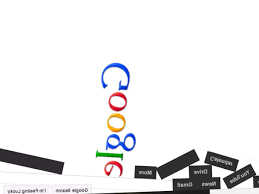Are you ready to defy the laws of physics and dive into a world where gravity is just a playful concept? Look no further because we are about to unleash the fun in this blog article as we explore the mind-bending phenomenon called Google Gravity. Get ready to experience a whole new dimension of entertainment, interactive magic, and endless amusement that will leave you questioning reality itself. So buckle up and prepare for an adventure like no other as we delve into the whimsical realm of Google Gravity!
Introduction to Google Gravity
Google Gravity is a fun and interactive feature that allows users to experience the force of gravity on their screens. This unique feature was created by Mr. Doob, a web developer known for his experimental and creative projects.
Initially released in 2009, Google Gravity quickly gained popularity among internet users due to its entertaining nature. It offers a different perspective from the traditional layout of Google’s search page, making it refreshing and exciting for users.
How Does it Work?
To experience Google Gravity, all you need is a stable internet connection and a modern web browser. Simply type “Google Gravity” into the search bar, and click on the first result that appears – “Mr. Doob.”
Once on Mr. Doob’s website, you will see the familiar Google logo at the top of your screen. However, as soon as you move your cursor or start typing in the search bar, everything starts falling down as if being pulled by gravity.
You can also interact with various elements such as links, images, and texts using your mouse cursor. You can drag them around or even throw them off-screen to watch them bounce back like real objects under the influence of gravity.
What Makes it Fun?
One of the reasons why people love Google Gravity is because it adds an element of surprise to their daily online activities. Instead of just searching for information using the regular interface, they get to play around with different objects while still getting relevant search results.
What is Google Gravity and How Does it Work?
Google Gravity is an entertaining and interactive feature developed by Google that adds an element of fun to your internet browsing experience. It was created by a group of Google engineers as an experiment to showcase the capabilities of JavaScript and HTML5. This playful feature can be accessed by simply typing “Google Gravity” into the search bar, clicking on the first result, and then watching as your screen undergoes a gravity-induced transformation.
So how does it work? When you open the Google Gravity page, you will see all the familiar elements of a typical Google search page – logo, search bar, and buttons. However, as soon as you move your cursor or click on any element, they will all start to fall towards the bottom of the screen due to the force of gravity. You can also use your mouse to drag and drop these elements around the screen like actual objects.
But that’s not all – there are other hidden surprises waiting for you in this anti-gravity world! For example, if you type something into the search bar while everything is still falling around, the letters will appear normal at first but then quickly get pulled down by gravity. You can even try searching for “Google Gravity” itself and watch what happens!
Moreover, you can interact with various objects scattered across your screen such as balls bouncing off each other or images rotating around a fixed point. These interactive elements add another level of entertainment to this already amusing feature.
The History of Google Gravity
Google Gravity is a widely popular web trick that has been around for over a decade, providing endless entertainment and fun to its users. The concept of Google Gravity was first introduced by the creative minds at Mr. Doob, a digital art studio based in Barcelona, Spain.
In 2009, the team at Mr. Doob created a website called “Google Sphere”, which allowed users to experience the sensation of browsing through a floating sphere filled with Google search results. The success of this project led to the creation of other Google experiments such as “Google Space” and “Google Gravity”. However, it was not until later that year when they launched “Google Gravity” as an independent website.
Initially, Google Gravity was designed as an experiment to showcase the capabilities of modern browsers like Chrome and Firefox, which were gaining popularity at that time. It quickly gained traction among internet users and became viral on social media platforms like Facebook and Twitter.
The original version of Google Gravity featured all elements on the webpage falling towards the bottom, giving an illusion of gravity pulling everything downwards. Users could still interact with these elements by clicking or dragging them around with their mouse cursor.
As its popularity grew, more variations of Google Gravity started appearing online. Some versions added additional effects like explosions or made everything float upwards instead of falling downwards. These variations contributed to keeping the trend alive and making it even more exciting for users to try out different versions.
Different Ways to Access Google Gravity
There are several different ways to access Google Gravity, each with its own unique features and options. In this section, we will explore the various methods of accessing Google Gravity and provide step-by-step instructions on how to do so.
1. Via the Official Google Gravity Website
The easiest way to access Google Gravity is through the official website created by Mr.Doob, a designer and programmer who developed the gravity feature as an experiment. To access it, simply type “Google Gravity” into your search engine and click on the first result that appears – it should be titled “Google Sphere.” This will take you to the website where you can experience all of the different gravity effects.
2. Using Chrome Extensions
If you use Google Chrome as your web browser, there are multiple extensions available that allow you to enable and customize Google Gravity without leaving your current tab or window. One popular extension is called “Google Space,” which allows you to interact with objects in a space-themed version of Google’s homepage.
To install this extension, go to the Chrome Web Store and search for “Google Space.” Click on “Add to Chrome” and then select “Add Extension” when prompted. The extension will now appear as a small icon next to your address bar – simply click on it whenever you want to activate Google Space.
Fun Experiments and Activities with Google Gravity
Google Gravity is an entertaining and interactive feature created by Google that allows users to experience the effects of gravity on their screen. It may sound simple, but it can provide hours of fun for people of all ages. In this section, we will explore some fun experiments and activities you can do with Google Gravity.
1. Play with the Elements
One of the first things you’ll notice when using Google Gravity is that all elements on the page start falling downwards due to the gravitational effect. But did you know that you can play around with these elements? You can click and drag objects like images, search boxes, or even text to see them move around in a comical way.
You can also try dragging multiple objects at once and watch as they collide and bounce off each other. This experiment not only showcases the effects of gravity but also allows you to unleash your creativity by creating unique designs and patterns on your screen.
2. Create Your Own Maze
Another exciting activity you can do with Google Gravity is creating your own maze using the falling objects as obstacles. All you have to do is arrange different objects strategically across the screen, making sure there are no gaps for easy navigation.
Once done, challenge yourself or your friends to navigate through the maze without touching any falling object. You can even time yourselves to see who completes it faster. This activity not only tests your hand-eye coordination but also adds an element of competition and excitement to using Google Gravity.
Tips for Using Google Gravity Safely
Google Gravity is a fun and interactive feature that allows you to experience the effects of gravity on your Google search page. While it can be a great way to add some entertainment to your browsing, it’s important to use Google Gravity safely to avoid any potential issues or complications.
Here are some tips for using Google Gravity safely:
- Use it on a stable internet connection: Google Gravity requires a stable internet connection in order to function properly. If your connection is weak or unstable, it may cause the page elements to load incorrectly and result in unexpected behaviors. So before you start playing with Google Gravity, make sure you have a strong and stable internet connection.
- Only use trusted sources for accessing Google Gravity: There are many websites out there claiming to offer the Google Gravity feature, but not all of them are legitimate. To ensure your safety and protect against potential malware or scams, only access Google Gravity through reputable sources such as the official Google website.
- Avoid sensitive searches: While using Google Gravity, it’s best to avoid searching for anything sensitive or personal such as banking information, passwords, or other private details. This is because when the page elements are falling and bouncing around, it becomes difficult to accurately click on specific links or buttons without accidentally clicking on something else.
Alternatives to Google Gravity
Google Gravity is a popular and entertaining trick that has been enjoyed by many users since its creation. However, if you’re looking for some other similar tricks or alternatives to Google Gravity, you’ve come to the right place! In this section, we will explore some of the most popular alternatives to Google Gravity that are sure to bring even more fun and excitement into your browsing experience.
1. Google Sphere:
If you love the gravity effect of Google Gravity but want a different theme, then Google Sphere is the perfect alternative for you. This trick creates a 3D sphere with all the elements on the page rotating around it. It’s mesmerizing to watch and can be accessed by simply typing “sphere” instead of “gravity” in the search bar.
2. Zero Gravity Google:
As the name suggests, Zero Gravity Google creates an anti-gravity effect where all elements on the page float freely without any gravitational pull. This alternative also allows users to interact with the elements by dragging them around and creating their own unique patterns.
3. Anti-Gravity Google:
Similar to Zero Gravity Google, Anti-Gravity Google also removes all gravitational forces from elements on the page. However, this version adds another twist by making everything move in random directions when clicked or dragged.
Conclusion
The Google Gravity experiment is a fun and interactive way to explore the possibilities of technology. Through this blog article, we have delved into the various features and tricks of Google Gravity that can add an extra element of excitement to your internet browsing experience. From floating objects to falling text, we have seen how Google Gravity can turn the mundane task of searching into an entertaining activity.
Read more informative articles!













